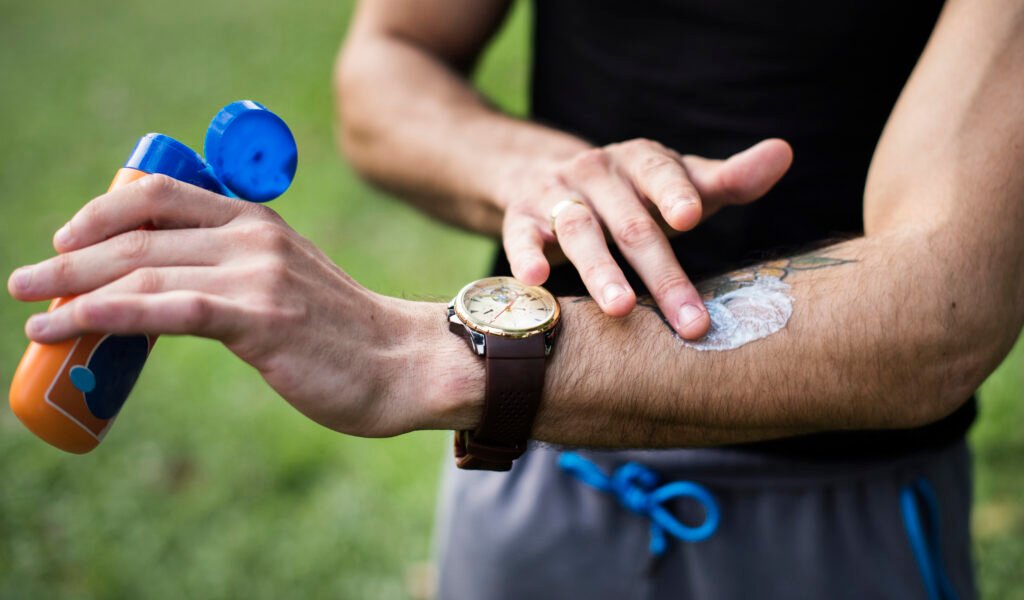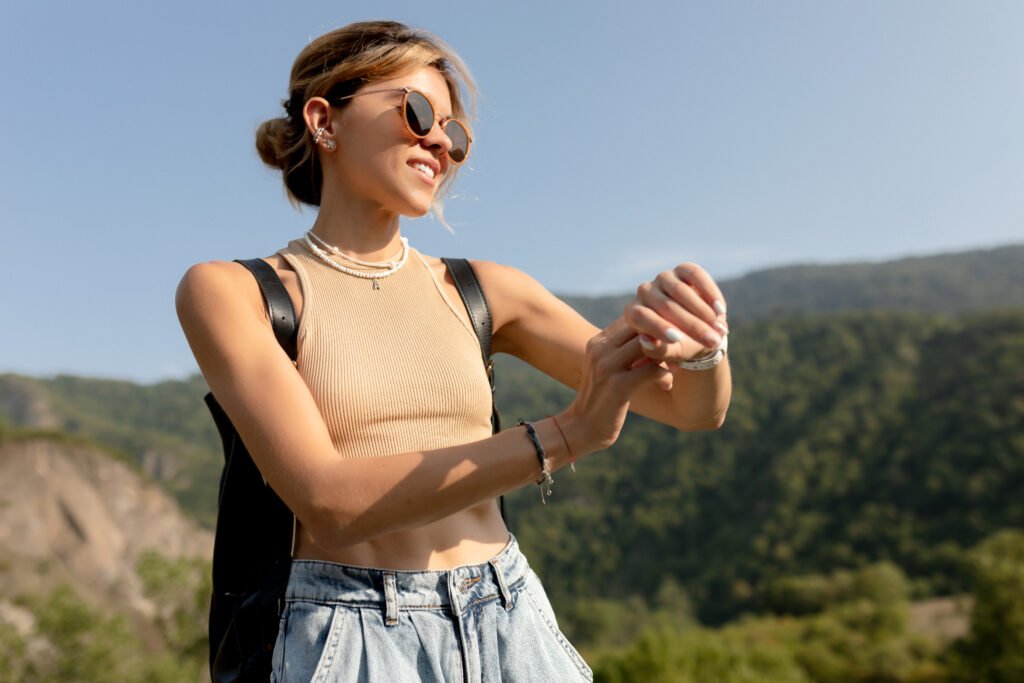How to Choose Sunscreen for Hiking: The Complete Guide
Introduction
Choosing the right sunscreen for hiking is more than just grabbing any bottle off the shelf. When you’re on the trail, your skin faces intense UV exposure, environmental elements, and physical activity that regular daily sunscreen might not be equipped to handle.
This guide will help you navigate the complex world of sun protection specifically for hiking and outdoor adventures.
Why Sunscreen is Non-Negotiable for Hikers
Hiking exposes you to heightened UV radiation for several reasons:
- Higher elevations increase UV intensity (UV radiation increases about 4-10% for every 1,000 feet of elevation)
- Longer exposure time outdoors
- Reflection from surfaces like water, snow, and even light-colored rock (snow can reflect up to 80% of UV radiation)
- Reduced protection from shade while on open trails

Consequences of an inadaquate sun protection choose
The consequences of inadequate sun protection for hikers include:
- Severe sunburn that can ruin a multi-day trek
- Increased risk of skin cancer (melanoma and non-melanoma)
- Premature skin aging
- Heat exhaustion or heat stroke when combined with sunburn
- Long-term skin damage that accumulates over years of hiking
According to the Skin Cancer Foundation’s 2023 Outdoor Recreation Sun Safety Report, hikers face up to 25% more UV radiation exposure than the average outdoor enthusiast due to elevation changes, longer duration activities, and reduced shade opportunities.
Understanding the Sunscreen Basics
SPF (Sun Protection Factor)
SPF measures protection against UVB rays, which cause sunburn and contribute to skin cancer.
For hiking:
- Minimum SPF 30 (blocks about 97% of UVB rays)
- Recommended SPF 50 for high altitudes, snow, or desert hiking (blocks about 98% of UVB rays)
- Higher SPF gives you slightly more protection and a larger margin of error in application
What SPF Really Means
SPF (Sun Protection Factor) is often misunderstood by hikers and outdoor enthusiasts. Rather than being a strength indicator, SPF actually represents the theoretical time extension of protection.
For example, if your unprotected skin typically burns after 10 minutes of sun exposure, an SPF 30 product would theoretically protect you for 300 minutes (10 minutes × 30).
However, this formula is highly theoretical and doesn’t account for real-world conditions like sweating, rubbing, or uneven application.
More accurately, SPF indicates the percentage of UVB rays blocked:
1. SPF 15 blocks approximately 93% of UVB rays
2. SPF 30 blocks approximately 97% of UVB rays
3. SPF 50 blocks approximately 98% of UVB rays
4. SPF 100 blocks approximately 99% of UVB rays
Notice that the protection increase diminishes as numbers get higher—the jump from SPF 30 to SPF 50 only provides about 1% more protection. However, for hikers exposed to intense conditions, this small percentage can make a meaningful difference over extended periods outdoors.

Why Higher SPF Matters for Hikers
For general daily use, dermatologists often suggest SPF 30 is sufficient, but hiking presents unique challenges:
Application realities: Studies show most people apply only 25-50% of the recommended sunscreen amount. At higher elevations or during extended hikes, using a higher SPF provides a safety margin against underapplication.
Environmental factors: UV radiation increases approximately 4-10% with every 1,000 feet of elevation gain. A hiker at 9,000 feet could experience up to 90% stronger UV radiation than at sea level, quickly overwhelming lower SPF products.
Duration consideration: While all sunscreens require reapplication regardless of SPF, higher numbers provide better protection during the inevitable gaps between applications on long trails.
Sweat degradation: Intense hiking causes heavy perspiration that breaks down sunscreen faster than under normal conditions. Higher SPF formulations typically contain more UV-filtering ingredients that may maintain minimum effective protection longer during activity.
For most hiking scenarios, experts recommend a minimum of SPF 30, with SPF 50+ being ideal for high-altitude treks, snow or water activities, desert hikes, or individuals with fair skin or history of skin cancer.
Broad Spectrum Protection
Ensure your sunscreen offers “broad spectrum” protection, covering:
- UVB rays (cause sunburn)
- UVA rays (cause skin aging and penetrate deeper into skin)
When selecting sunscreen for hiking, it’s essential to understand what “broad spectrum” truly means. This designation isn’t just marketing—it indicates that the sunscreen protects against both types of harmful ultraviolet radiation.
What is the difference between grape and UVB
UVB rays primarily affect the outer layer of skin, causing the redness and pain associated with sunburn. These rays are strongest during peak daylight hours and at higher elevations, making them particularly concerning for hikers.
Meanwhile, UVA rays penetrate more deeply into the dermis (the skin’s second layer) and are present with consistent strength during all daylight hours, regardless of season or weather conditions. UVA exposure leads to premature aging, including wrinkles, leathery texture, and age spots. More concerning, both UVA and UVB rays contribute to skin cancer development through DNA damage.
For hikers, this dual protection is non-negotiable because trails often offer minimal shade, and activities typically occur during peak UV hours. Furthermore, standard window glass blocks UVB but not UVA rays, which means you haven’t built up tolerance to UVB rays if you spend time indoors near windows, making proper protection even more crucial when hitting the trails.
Always check for the words “Broad Spectrum” on the label—this indicates the product has passed specific FDA testing for protection against both types of radiation. Without this designation, you’re only getting partial protection, which is inadequate for the extended exposure typical of hiking adventures

Water and Sweat Resistance
Water and Sweat Resistance
For hiking, this is crucial:
- First and foremost, “Water-resistant” sunscreens maintain effectiveness for 40 minutes in water
- Meanwhile, “Very water-resistant” sunscreens work for 80 minutes
- However, note that no sunscreen is truly waterproof or sweatproof
- Therefore, reapplication is necessary regardless of resistance claims
Sunscreen Types for Hiking
Chemical Sunscreens
- How they work: Absorb UV rays and convert them to heat
- Pros: Lightweight, easy to apply, transparent, often preferred for daily use
- Cons: Can irritate sensitive skin, may sting eyes when sweating, besides some ingredients raise environmental concerns
- Best for: Face application, high-intensity activities where weight matters
Mineral (Physical) Sunscreens
- How they work: Contain zinc oxide and/or titanium dioxide that reflect UV rays
- Pros: Work immediately upon application, less irritating for sensitive skin, more environmentally friendly, better heat tolerance
- Cons: Can leave white cast, thicker consistency, may need more frequent reapplication when sweating heavily
- Best for: Sensitive skin, children, environmentally conscious hikers
Hybrid Formulations
- Combine chemical and mineral filters
- Offer benefits of both types with fewer drawbacks
- Good all-around choice for many hikers
Choosing Sunscreen by Hiking Environment
Mountain/Alpine Hiking
- UV Intensity: Extremely high due to elevation and possible snow reflection
- Recommendation: SPF 50+, very water-resistant, mineral-based often preferred due to extreme conditions
- Additional needs: Lip protection with SPF, snow-specific formulations if hiking on snow
Desert Hiking
- UV Intensity: Extreme with minimal shade
- Recommendation: SPF 50+, very water-resistant, heat-stable formulation
- Consider: Oil-free, non-comedogenic formulas that won’t clog pores when mixed with sweat
Forest/Woodland Hiking
- UV Intensity: Moderate (but don’t be fooled by shade)
- Recommendation: SPF 30-50, water-resistant
- Notes: Even in forests, UV rays penetrate canopy gaps and reflect off surfaces
Coastal/Beach Hiking
- UV Intensity: High due to water reflection
- Recommendation: Reef-safe formulations, very water-resistant, SPF 50
- Additional needs: Formulations that won’t wash off easily with swimming or high humidity
Winter Hiking
- UV Intensity: Surprisingly high due to snow reflection
- Recommendation: Cold-resistant formulations (some sunscreens can freeze), SPF 50+
- Consider: Moisturizing formulas to combat winter dryness
Choosing SUNSCREEN by Skin Type
Fair or Light Skin (Skin Types I & II)
- Burns easily, rarely tans
- Recommendation: SPF 50+, reapplication every 1-2 hours
- Best ingredients: Mineral sunscreens often better for reactive skin common in fair skin types
Medium Skin (Skin Types III & IV)
- Burns moderately, tans gradually
- Recommendation: Minimum SPF 30, ideally SPF 50 for hiking
- Considerations: Both chemical and mineral options suitable
Dark Skin (Skin Types V & VI)
- Rarely burns, tans easily
- Recommendation: Minimum SPF 30 (sun damage still occurs even without visible burning)
- Considerations: Tinted mineral sunscreens to avoid white cast
Sensitive or Acne-Prone Skin
- Recommendation: Mineral sunscreens, fragrance-free, oil-free formulations
- Look for: “Non-comedogenic” on the label
- Avoid: Ingredients like oxybenzone, avobenzone, octinoxate in sensitive skin
Application Techniques for Hikers
Amount
- Use approximately 1 oz (a shot glass full) for full-body application
- Face and neck alone need about 1/4 teaspoon
- Underapplication is the most common mistake hikers make
Timing
- Apply chemical sunscreens 15-30 minutes before sun exposure
- Mineral sunscreens can be applied immediately before heading out
- Apply before leaving camp or trailhead, not when you’re already on the trail
Reapplication Strategy
- Every 2 hours of hiking minimum
- After swimming or excessive sweating
- More frequently at high altitudes or in extreme conditions
- Set timer reminders on your watch or phone
Common Miss Spots for Hikers
- Back of neck (especially with backpacks)
- Ears and back of ears
- Hairline and part lines
- Tops of feet if wearing sandals
- Backs of legs
- Lips (use dedicated SPF lip balm)
Top Sunscreen Recommendations for HiKING
Best Overall Sunscreens for Hiking
- La Roche-Posay Anthelios Melt-In Milk SPF 60: Fast-absorbing, very water-resistant, works well under backpack straps
- Neutrogena Ultra Sheer Dry-Touch SPF 100+: Extremely high protection, non-greasy finish
- ThinkSport SPF 50+: Mineral-based, highly water-resistant, environmentally friendly
The Best SUNSCREENS for Sensitive Skin
- Blue Lizard Sensitive Mineral Sunscreen SPF 50+: Gentle formulation, no irritating chemicals
- Vanicream Sunscreen SPF 50+: Free of dyes, fragrance, preservatives
- CeraVe Hydrating Mineral Sunscreen SPF 50: Contains ceramides to support skin barrier
Best for Face
- EltaMD UV Sport SPF 50: Oil-free, won’t run into eyes when sweating
- Supergoop! Unseen Sunscreen SPF 40: Completely clear, works well under makeup for day hikes
- Sun Bum Face 50: Lightweight, designed not to clog pores
BEST Budget Options
- Coppertone Sport SPF 50: Affordable, widely available, decent water-resistance
- Banana Boat Sport Ultra SPF 50+: Budget-friendly and performs well for shorter hikes
- Generic store brands from REI or outdoor retailers: Often comparable to name brands at lower price
MOST RECOMMENDED Eco-Friendly SUNSCREEN Options
- Raw Elements Face + Body SPF 30: Plastic-free packaging, reef-safe ingredients
- All Good Sport Sunscreen SPF 50: Plant-based ingredients, environmentally friendly
- Stream2Sea Sport Sunscreen SPF 30: Tested to be safe for marine ecosystems

Sunscreen Supplements and Alternatives FOR HIKING
While these don’t replace sunscreen, they complement protection:
UPF Clothing
- Consider UPF-rated shirts, hats, and buffs (UPF 50+ recommended)
- More reliable than regular clothing for sun protection
- Can reduce the amount of exposed skin needing sunscreen
Hats and Sunglasses
- Wide-brimmed hats protect face, ears, and neck
- Category 3 or 4 sunglasses shield eyes from UV damage
- Essential companions to sunscreen for comprehensive protection
Timing Your Hike
- Plan difficult sections for morning or late afternoon when possible
- Be extra vigilant with sunscreen between 10 AM and 4 PM
- Don’t be fooled by cloudy days – up to 80% of UV rays penetrate cloud cover

Special Considerations
High Altitude Hiking
- UV increases approximately 4-10% per 1,000 feet of elevation gain
- At 10,000 feet, UV radiation is nearly 50% stronger than at sea level
- Use the highest SPF and reapply more frequently above tree line
Multi-Day Backpacking
- Pack sufficient sunscreen (approximately 1 oz per person per day)
- Consider solid stick sunscreens to avoid leaks in your pack
- Store sunscreen in accessible locations for easy reapplication
Winter and Snow Sports
- Snow reflects up to 80% of UV radiation (almost like getting double exposure)
- Cold air and wind can make skin more vulnerable to damage
- Use moisturizing sunscreen formulations to combat dryness
FAQs About Sunscreen for Hiking
Q1: Does sunscreen expire?
A: Yes. Most sunscreens are effective for about 3 years from manufacture.
If exposed to high heat (like leaving in a hot car), efficacy decreases faster. Always check expiration dates before hiking season.
Q2: Is higher SPF always better?
A: Not necessarily although SPF 30 blocks about 97% of UVB rays, while SPF 50 blocks about 98%.
The difference is marginal, but for hiking, the extra protection and margin for error with SPF 50+ is recommended.
Q3: Should I use different sunscreens for my face and body when hiking?
A: This can be beneficial. Face-specific formulations are often designed not to clog pores or irritate sensitive facial skin. They may also be less likely to run into eyes when sweating.
Q4: Are spray sunscreens good for hiking?
A: While convenient, spray sunscreens often result in uneven application and inhalation concerns. If using sprays, spray into hand first then apply, and ensure adequate coverage.
Q5: Do I need sunscreen on cloudy days?
A: Absolutely. Up to 80% of UV rays penetrate cloud cover.
Some of the worst sunburns happen on overcast days because hikers let their guard down.
FINAL THOUGHTS
Choosing the right sunscreen for hiking is an essential part of outdoor safety, just like bringing adequate water and navigation tools.
The perfect sunscreen matches your skin type, hiking environment, and personal preferences while providing adequate protection against both UVA and UVB rays.
Remember that consistent application and reapplication are just as important as the product you choose. Even the best sunscreen fails if used incorrectly or sparingly.
Make sun protection a non-negotiable part of your hiking routine, and your skin will thank you for decades to come.
By understanding the science behind sunscreen and applying this knowledge to your specific hiking needs, you’re not just preventing sunburn—you’re making a long-term investment in your skin health that will allow you to enjoy the trails for many years ahead.
Sunlight is wonderful but it can be dangerous if we don’t take precautions, discover other risks associated with the sun and heat while hiking









